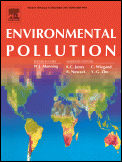Environmental Pollution 170
Overview of new articles on POPs in a new issue of the Environmental Pollution journal.

Pages 1-7
Yan Wang, Zhineng Cheng, Jun Li, Chunling Luo, Yue Xu, Qilu Li, Xiang Liu, Gan Zhang
- A gradient of PCN levels between highly and less developed areas was observed.
- CN 51 may be a new specific source indicator compared to other congeners.
- Soil acts as a secondary source in summer and a recipient in winter for PCNs in PRD.
- Low-chlorinated PCNs released from the PRD may transport to North China
Pages 26-31
Hong Chen, Can Zhang, Jianbo Han, Yixuan Yu, Peng Zhang
- Levels of PFOS and PFOA in influents, effluents and sludge from Chinese WWTPs were examined.
- Municipal sewage was the main source for PFOS in Chinese WWTPs, while industrial sewage for PFOA.
- PFOS and PFOA concentrations in effluents were much higher than those in receiving seawater.
High levels of DDT in breast milk: Intake, risk, lactation duration, and involvement of gender
Pages 63-70
Hindrik Bouwman, Henrik Kylin, Barbara Sereda, Riana Bornman
- The highest ΣDDT in breast milk ever found in South Africa is reported.
- Maximum Residue Limit is exceeded, up to 99 times.
- Provisional Tolerable Daily Intake is exceeded, up to 310 times.
- High ΣDDT did not affect duration of lactation.
- Infant gender may affect levels of ΣDDT in breast milk.
Pages 71-77
Zhen Zhao, Zhiyong Xie, Axel Möller, Renate Sturm, Jianhui Tang, Gan Zhang, Ralf Ebinghaus
- PFOA is released from the Arctic snow and ice and might be transport southwards to the Atlantic.
- Decline temporal trends of PFASs are present in the Northern Hemisphere in the Atlantic.
- PFOS has elevate concentration in comparison to PFOA in the Southern Ocean.
Pages 145-151
Xiao-ping Wang, Jiu-jiang Sheng, Ping Gong, Yong-gang Xue, Tan-dong Yao, Kevin C. Jones
- Soil organic carbon content influence the spatial distribution of persistent organic pollutants.
- The Tibetan soil acts as “secondary sources” for HCB, low molecular weight PCBs and HCHs.
- The Tibetan soil will continue to be “sinks” for DDE and DDT.
Relationships between aging of PAHs and soil properties
Pages 177-182
Lei Luo, Shu Lin, Honglin Huang, Shuzhen Zhang
- PAH aging exhibits a biphasic behavior in the soils.
- The rapid diffusion depends on meso- and micropore distribution and TOC content.
- The slow diffusion is controlled by hard organic carbon and pore distribution.
- Hard organic carbon can act as a better predictor of PAH sequestration than TOC.
Pages 183-189
Guo-Li Yuan, Wei Xie, Xiao-Chao Che, Peng Han, Chen Liu, Gen-Hou Wang
- All data about soil and PBDEs were based on field data rather than experiments.
- The intermediate fraction of PBDEs increased with increases in the clay content.
- The clays were more strongly correlated with PBDEs fractional patterns than SOC.
Pages 260-267
Jiajiang Lin, Yan He, Jianming Xu
- The extent of the aerobic/anaerobic interface depends upon the soil properties.
- The dissipation of PCP was accelerated in some soils due to the soil-water interface.
- The addition of oxidants inhibited the decrease in soil redox potential.
- Most external oxidants added under flooded condition inhibited PCP dechlorination.
Pages 268-275
Anna M. Roos, Britt-Marie V.M. Bäcklin, Björn O. Helander, Frank F. Rigét, Ulla C. Eriksson
- We compared trends of reproductive success in three aquatic top predators in Sweden.
- The study period covers four decades.
- Similar, increasing trends are seen from the end of the 1980s for otters, grey seals and sea eagles.
- Concentrations of total-PCB and DDTs have decreased in these species at similar rates.
- PCBs and DDTs have severely affected reproductive success in these species.
9.8.2012




